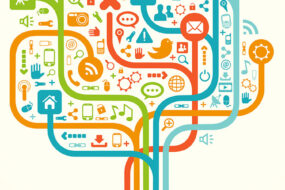
Blockchain technology, originally developed as the foundation for Bitcoin and other cryptocurrencies, is increasingly being recognized for its potential far beyond the realm of digital currency. This decentralized, immutable ledger system has the power to transform a wide range of industries by providing transparency, security, and efficiency in ways that traditional centralized systems cannot. In this article, we explore how blockchain is evolving and discuss its growing applications in fields such as supply chain management, healthcare, and finance—proving that blockchain’s impact extends far beyond just cryptocurrencies.
1. Supply Chain Management: Enhancing Transparency and Efficiency
One of the most promising real-world applications of blockchain is in supply chain management. Traditional supply chains often involve complex networks of suppliers, manufacturers, and distributors, each with their own systems and records. This can lead to inefficiencies, fraud, and a lack of transparency. Blockchain can streamline and secure these processes by providing a single, immutable record of all transactions that occur along the supply chain.
Key Benefits of Blockchain in Supply Chain:
- Enhanced Transparency: With blockchain, every step in the supply chain can be tracked and verified in real-time. From raw materials to finished products, blockchain ensures that all transactions are visible to stakeholders, reducing the risk of fraud, counterfeiting, and errors.
- Improved Traceability: Consumers and businesses can track products to their origin. For example, in the food industry, blockchain can help trace the journey of food from farm to table, ensuring quality control and compliance with safety standards.
- Faster and Cheaper Transactions: Blockchain eliminates intermediaries, reducing the time and cost associated with processing payments and documentation. This is particularly beneficial in international trade, where traditional payment systems can be slow and expensive.
Real-World Example:
- Walmart and IBM: Walmart has partnered with IBM to use blockchain for food traceability. This initiative allows the company to track the journey of produce from farm to store in real-time, ensuring food safety and reducing the impact of recalls.
2. Healthcare: Securing Medical Data and Improving Patient Care
In the healthcare industry, managing patient data securely and efficiently is a growing challenge. Blockchain’s decentralized and immutable nature provides an ideal solution for addressing issues related to data security, privacy, and interoperability. By using blockchain to store medical records and patient data, healthcare providers can ensure that sensitive information is accessible only to authorized individuals, with a secure audit trail for accountability.
Key Benefits of Blockchain in Healthcare:
- Improved Data Security: Blockchain’s encryption and decentralization make it much harder for unauthorized individuals to access or tamper with medical records, reducing the risk of data breaches and identity theft.
- Interoperability: Healthcare providers often use different systems that are not compatible with one another. Blockchain can serve as a universal platform for sharing medical records across systems and institutions, improving collaboration between providers and enhancing patient care.
- Streamlined Billing and Payments: Blockchain can reduce fraud in medical billing by providing a transparent, auditable record of all transactions. It also enables more efficient insurance claim processing, reducing administrative costs and errors.
Real-World Example:
- MedRec: MedRec is a blockchain-based system developed by MIT that allows healthcare providers to securely share patient data. The platform enables patients to have full control over their health records, while medical professionals can access them when needed to improve care coordination.
3. Finance: Transforming Traditional Banking and Payments
Blockchain technology is already well-known in the financial sector due to its role in cryptocurrencies like Bitcoin. However, its potential in transforming traditional banking, payments, and other financial services goes far beyond digital currencies. Blockchain can make financial transactions faster, more secure, and less expensive by removing intermediaries and automating processes through smart contracts.
Key Benefits of Blockchain in Finance:
- Faster Transactions: Traditional banking systems, especially for cross-border payments, can take days to process. Blockchain allows for near-instantaneous transactions, reducing wait times and fees, and improving liquidity.
- Lower Transaction Costs: By eliminating the need for intermediaries like banks, clearinghouses, and payment processors, blockchain can reduce transaction fees, making financial services more affordable, especially for businesses and individuals in developing regions.
- Decentralized Finance (DeFi): Blockchain is the foundation of the growing DeFi movement, which is disrupting traditional financial services by offering decentralized lending, borrowing, and trading platforms that operate without centralized financial institutions.
Real-World Example:
- Ripple (XRP): Ripple is a blockchain-based payment protocol that enables fast, low-cost international money transfers. Ripple’s platform allows banks and financial institutions to send money across borders in seconds, compared to the traditional methods that can take days.
4. Identity Verification and Digital Authentication
Another exciting application of blockchain technology is in identity management. Traditional identity verification systems often rely on centralized databases, which are vulnerable to hacking and identity theft. Blockchain offers a more secure and user-centric way of managing digital identities, allowing individuals to control access to their personal information and prove their identity without relying on a third party.
Key Benefits of Blockchain for Identity:
- Self-Sovereign Identity: Blockchain allows individuals to control their identity by using a decentralized system where personal data is stored in encrypted blocks. This eliminates the need for centralized authorities to verify identity, reducing the risk of fraud and identity theft.
- Improved Security: Blockchain’s immutability ensures that once identity data is recorded, it cannot be tampered with, making it more secure than traditional methods of authentication.
- Streamlined Access to Services: Blockchain-based digital identity solutions allow individuals to verify their identity in a secure, fast, and privacy-respecting manner, making it easier to access services like healthcare, banking, and government benefits.
Real-World Example:
- U-Port: U-Port is a blockchain-based platform that enables individuals to create and manage their digital identities. Users can control their identity and share data selectively with trusted organizations, making it easier to authenticate themselves online and access services without compromising privacy.
5. Voting Systems: Ensuring Fairness and Transparency
Blockchain is also being explored as a solution for improving elections and voting systems. Traditional voting methods are often prone to fraud, manipulation, and lack of transparency, especially in countries with less robust electoral systems. Blockchain’s transparent and tamper-proof nature makes it an ideal candidate for securing the voting process.
Key Benefits of Blockchain in Voting:
- Immutability: Once a vote is cast on a blockchain, it cannot be altered or tampered with. This ensures the integrity of the election results.
- Transparency and Verifiability: Blockchain allows all stakeholders, including voters, to track and verify the voting process, ensuring transparency and accountability in elections.
- Increased Voter Accessibility: Blockchain-based voting systems could allow for more accessible, secure, and remote voting options, increasing voter participation and engagement.
Real-World Example:
- Voatz: Voatz is a blockchain-based voting platform used in pilot programs for absentee voting in the United States. It uses blockchain to securely record votes and ensure transparency while allowing voters to participate remotely.
6. Intellectual Property and Digital Rights Management
Blockchain technology can provide a more efficient and transparent way of managing intellectual property (IP) and digital rights. By using blockchain to track ownership and usage of digital assets, artists, musicians, and content creators can ensure that their intellectual property is protected and that they are fairly compensated.
Key Benefits of Blockchain in IP:
- Proof of Ownership: Blockchain provides a verifiable record of ownership, ensuring that creators retain control over their digital assets and that their IP is protected.
- Fair Compensation: Smart contracts on the blockchain can automate royalty payments, ensuring that content creators are compensated fairly and promptly when their work is used.
- Transparency: Blockchain allows for a transparent and accessible record of all transactions related to intellectual property, reducing disputes and making it easier to prove ownership.
Real-World Example:
- Ascribe: Ascribe is a blockchain platform that allows artists to register their digital works and prove ownership on the blockchain. It helps ensure that creators maintain control over their work and are paid for its use.
Conclusion: Blockchain’s Expanding Horizons
Blockchain technology is rapidly evolving beyond its association with cryptocurrencies, offering real-world applications that promise to enhance transparency, security, and efficiency across numerous industries. From revolutionizing supply chains to transforming healthcare, finance, and identity management, blockchain is proving that its potential extends far beyond digital currencies. As more industries begin to adopt this innovative technology, we can expect to see blockchain play a central role in shaping the future of business, governance, and society at large.








